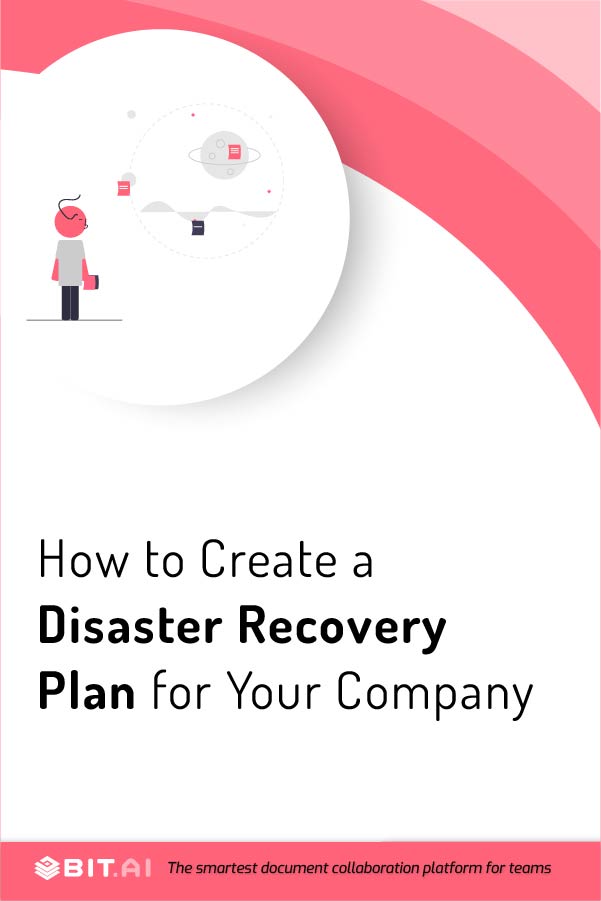Cybercrimes and security breaches have become more prevalent than ever. This is why it’s important for organizations to build data recovery and protection strategies.
That’s exactly where a disaster recovery plan comes into the picture.
It helps an organization quickly handle all the IT interruptions, reduce downtime, and minimizes financial and reputational damages.
In short, a disaster recovery plan (DRP) provides you with a clear roadmap to recovery! Want to learn more about DRPs and how to create them? Let’s go!
What is a Disaster Recovery Plan (DRP)?
A disaster recovery plan is a document that covers how an organization can resume work after a disaster strikes. This plan is used in all aspects of the organization that rely on informational technology (IT).
A disaster could be anything from application failure, cyber-attack, power outage, communication failure to natural disaster, building disaster, city-wide disaster, national disaster, or multinational disaster.
A disaster recovery plan (DRP) specifies what exactly the organization needs to do in order to minimize the effects of the disaster – so that it can continue its mission-critical operations.
Before creating a DRP, an organization first analyzes the business processes and continuity needs. Then, it performs a risk analysis (RA) and a business impact analysis (BIA) and sets recovery objectives.
People often get confused between a disaster recovery plan and a business continuity plan. Yes, a disaster recovery plan is a crucial part of a business continuity plan, but the two plans aren’t the same!
Read more: 9 Risk Management Tools & Techniques You Must Try!
Disaster Recover Plan VS Business Continuity Plan: What’s The Difference?
A business continuity plan (BCP) is mainly focused on keeping the business operations running – despite any hurdles and interruptions. Whereas, a disaster recovery plan is about overcoming these interruptions.
Let’s take an example.
A business continuity plan might include a complete backup production server that is similar to your active production server. This server can be used as soon as a disaster strikes, so there are no disruptions in service.
On the other hand, a disaster recovery plan might just include a data backup server that can store copies of all the critical data. A disaster recovery plan is less resource-intensive than a business continuity plan.
Now that you know what a disaster recovery plan is and how it’s different from a business continuity plan, let’s understand why you should create a disaster recovery plan in the first place.
Why You Should Create a Disaster Recovery Plan?
The need to drive superior customer experience and business growth fueled the use of information technology (IT) by organizations. The use of IT, however, increases infrastructure complexity and other risks.
Due to this complexity, organizations have to go through frequent outages, system breakdowns, cyber-attacks, and more. The impact of these outages and unplanned downtime is extremely high.
So, if you want to make your hybrid multi-cloud system resilient, you have to create a disaster recovery plan which includes integrated strategies for data protection and recovery, advanced technologies, etc.
A few more reasons why a business should create a comprehensive disaster recovery plan include:
- To lower disruption and damage.
- To limit the extent of economic impact caused by the interruption.
- To set alternative modes of operation in advance.
- To provide smooth and rapid restoration of service.
- To train employees with emergency procedures.
Creating a disaster recovery plan involves many steps! These steps might be different for different organizations, but here are the basic disaster recovery plan steps:
How to Create a Disaster Recovery Plan? (Steps)
Step 1: Assess The Risk
The first thing you need to perform is risk assessment (RA) and business impact analysis (BIA), as it will help you identify many potential disasters and interruptions.
Carefully analyze each functional area of the organization, and try to determine the consequences of disasters. Don’t forget to consider the infrastructure and geographical risk factors during risk analysis.
A good disaster recovery plan is the one that’s created by evaluating the risks beforehand. This allows business operations to continue for the customers, while IT addresses the disaster and its consequences.
Step 2: Evaluate Critical Needs
The next thing you need to do is evaluate the critical needs of every department and establish priorities accordingly. Here are some of the details that you need to include.
- Special security procedures.
- Guarantee of compatibility.
- Availability, cost & duration.
- Hours of operation.
- Termination conditions.
- What constitutes an emergency.
- Non-mainframe resource requirements & personnel requirements.
- Service extension negotiation process.
- Other contractual issues.
Read More: Incident Report: What is it & How to Write it the Right Way!
Step 3: Set Objectives of The Disaster Recovery Plan
Now, create a list of all the mission-critical operations and then identify which equipment, data, and applications are required to support these operations.
Then, determine each function’s recovery time objective (RTO) based on the cost of downtime! RTO is essentially the target amount of time in which an application can be offline without a negative business impact.
You also need to determine the recovery point objective (RPO), which is the duration in which you must solve any application issues. This is basically the quantity of data that the organization can afford to lose.
Step 4: Create The Document, Test & Revise
Once you’ve collected all the data (required inventory, procedures for system recovery, master vendor list, schedule for data backup, etc.), write it down in your disaster recovery plan in a structured manner.
Next, establish a procedure and criteria for testing the plan. This helps in ensuring that the organization has adopted the right backup procedures and facilities, and identifying areas that need improvement.
Lastly, test the plan based on the criteria and procedure you’ve set. You can conduct full interruption tests, simulation tests, checklist tests, parallel tests, etc.
Yes, it can be cumbersome and exhausting to draft a solid disaster recovery plan and that’s why there are so many people out there who are struggling with this task.
However, that doesn’t change the fact that a disaster recovery plan is one of the most valuable documents. Fortunately, we’ve something that will help you create a disaster recovery plan seamlessly – Bit.ai.
After getting familiar with Bit.ai, your perception that creating a disaster recovery plan is tough will change forever. Bit is all action-oriented and easy to use, so you can create the best documents ever.
Bit.ai – The Best Platform For Creating a Disaster Recovery Plan (And All Other Plans)
Bit.ai is a robust, new-age document management and collaboration platform where you can create, collaborate, share, track and manage all your documents in one place.
Bit.ai offers everything you’ll ever need to master your disaster recovery plan or any other document for that matter. Want to know a few more reasons why you should use Bit for your disaster recovery plan? Read on!
1. Real-Time Collaboration
While creating your disaster recovery plan, you need inputs and insights from your entire team so that you don’t end up miscalculating and misinterpreting things.
Bit.ai helps you do that effortlessly. Bit lets you and your team collaborate on a Bit document in real-time by co-editing, making inline comments, accessing version history, chatting via document chat, and much more.
It is an amazing way for your team to handle different aspects of your plan together in one place. That means, no more communicating back and forth through emails and messages with your team!
2. Smart Workspaces
Research is something that can never be carried out using one piece of document, especially when it comes to the disaster recovery plan. There is just so much different information that you need to gather from different aspects of your organization – and storing all this information can be a pain.
Luckily, Bit solves this problem for you. On Bit, you can gather your team and create workspaces around different markets, target audiences, and teams to keep all your research data organized.
3. Interactive Documents
What if you could keep all your important files in one single document? We’re talking about those excel sheets, presentations, charts, and more.
Won’t that make your disaster recovery plan much more comprehensive? The best part – your team won’t have to jump through different files to get information.
It’s possible using Bit! Bit lets you add images, videos, social media content, music/podcast, cloud files, surveys/polls, charts, code, presentations, and any other rich media you can think of in your Bit doc.
4. Pre-Built, Beautiful & Fully-Responsive Templates
Bit.ai offers 90+ gorgeous document templates and takes care of the design and formatting aspects for you so you can focus on research and content. As we said, creating a disaster recovery plan is not so tough when Bit has got your back.
5. Permissions & Sharing in Multiple Ways
Yes, the people who are already there in your workspace can see the documents whenever they want. However, there are more ways to share your Bit document – you can create a shareable live link, embed your docs onto any website and even invite guests into your workspace.
Guest access is best if you just want someone from the team to review your documents in a particular workspace, but you don’t want them to see anything else.
Wrapping Up
If you want to continue your critical business operations no matter what happens, you need to be able to restore all the critical systems within minutes of disruption.
A disaster recovery plan helps you do just that! With this plan in place, you can quickly get things back up and running, and also prevent disasters!
We know that there’s a lot of information to digest here, so if you have got any queries, suggestions, or concerns, hit us up on Twitter at @bit_docs. We would be happy to help you. Cheers!
Further Reads:
Crisis Management Plan: Definition, Types & Steps to Create!
Information Security Plan: What is it & How to Create it?
Risk Management Plan: What is it and How to Create it?
Management Plan: Definition, Benefits & How To Create One?
Cost Management Plan: What is it & How to Create it the Right Way?
Mitigation Plan: What Is It & How To Create One?
Contingency Plan: Definition, Importance & Format!


Related posts
Bit.ai | Watch to Learn More
What is Bit.ai?
Bit.ai is an innovative AI-driven knowledge and Document Managment suite designed to empower knowledge workers by streamlining the creation of, documents, wikis, and notes. With an intuitive interface and seamless integration, Bit.ai acts as a versatile assistant to help you collaborate, generate, organize, and visualize your ideas effortlessly. Whether you are drafting a report, managing a project, collaborating with your team or clients, or brainstorming new concepts, Bit.ai brings intelligence and creativity to every aspect of your work process.


